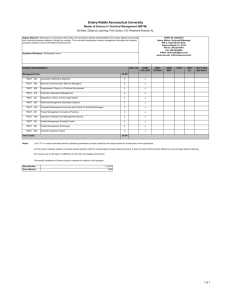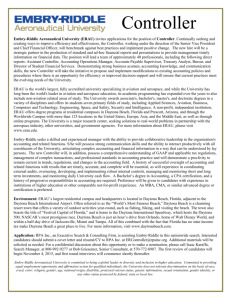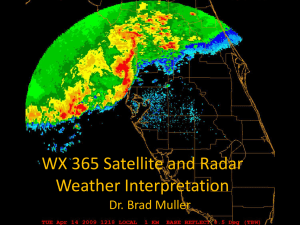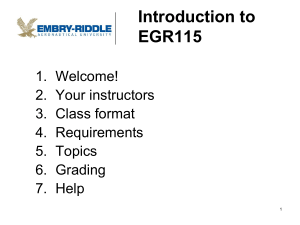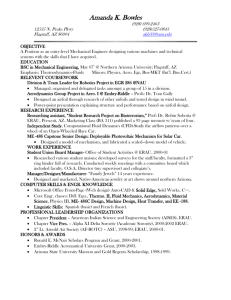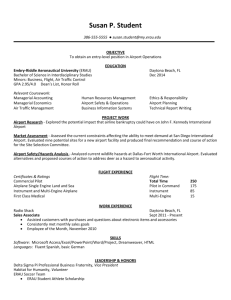look inside - Embry-Riddle Aeronautical University
advertisement
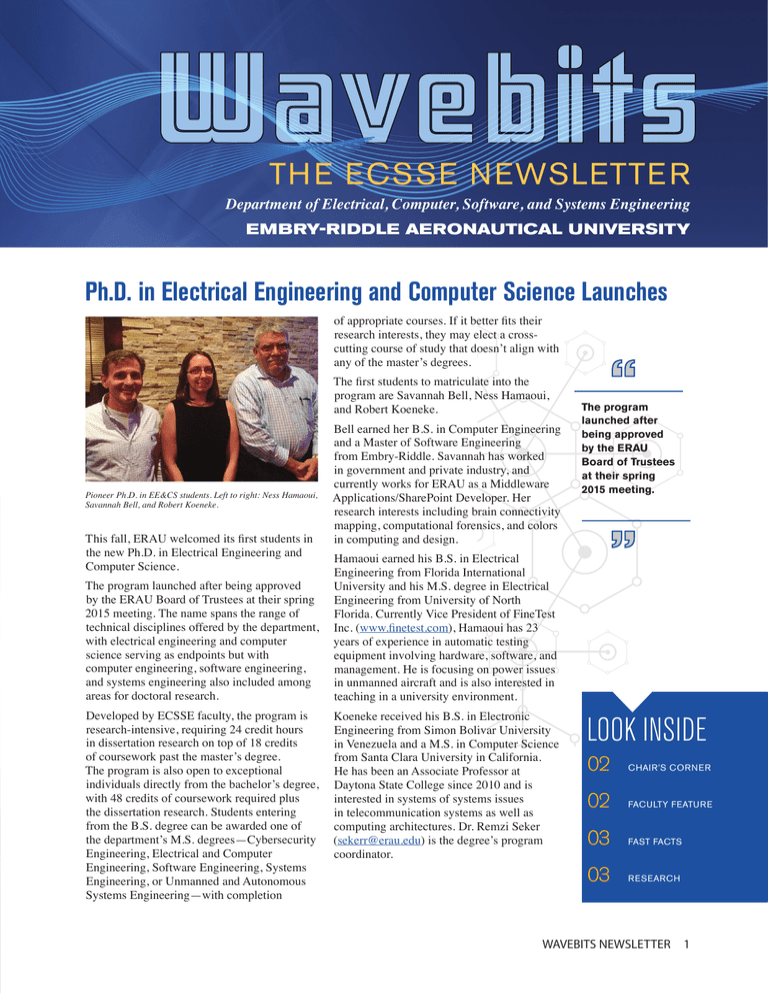
TH E ECSSE N EWSLETTE R Department of Electrical, Computer, Software, and Systems Engineering EMBRY-RIDDLE AERONAUTICAL UNIVERSITY Ph.D. in Electrical Engineering and Computer Science Launches of appropriate courses. If it better fits their research interests, they may elect a crosscutting course of study that doesn’t align with any of the master’s degrees. The first students to matriculate into the program are Savannah Bell, Ness Hamaoui, and Robert Koeneke. Pioneer Ph.D. in EE&CS students. Left to right: Ness Hamaoui, Savannah Bell, and Robert Koeneke. This fall, ERAU welcomed its first students in the new Ph.D. in Electrical Engineering and Computer Science. The program launched after being approved by the ERAU Board of Trustees at their spring 2015 meeting. The name spans the range of technical disciplines offered by the department, with electrical engineering and computer science serving as endpoints but with computer engineering, software engineering, and systems engineering also included among areas for doctoral research. Developed by ECSSE faculty, the program is research-intensive, requiring 24 credit hours in dissertation research on top of 18 credits of coursework past the master’s degree. The program is also open to exceptional individuals directly from the bachelor’s degree, with 48 credits of coursework required plus the dissertation research. Students entering from the B.S. degree can be awarded one of the department’s M.S. degrees—Cybersecurity Engineering, Electrical and Computer Engineering, Software Engineering, Systems Engineering, or Unmanned and Autonomous Systems Engineering—with completion Bell earned her B.S. in Computer Engineering and a Master of Software Engineering from Embry-Riddle. Savannah has worked in government and private industry, and currently works for ERAU as a Middleware Applications/SharePoint Developer. Her research interests including brain connectivity mapping, computational forensics, and colors in computing and design. The program launched after being approved by the ERAU Board of Trustees at their spring 2015 meeting. Hamaoui earned his B.S. in Electrical Engineering from Florida International University and his M.S. degree in Electrical Engineering from University of North Florida. Currently Vice President of FineTest Inc. (www.finetest.com), Hamaoui has 23 years of experience in automatic testing equipment involving hardware, software, and management. He is focusing on power issues in unmanned aircraft and is also interested in teaching in a university environment. Koeneke received his B.S. in Electronic Engineering from Simon Bolivar University in Venezuela and a M.S. in Computer Science from Santa Clara University in California. He has been an Associate Professor at Daytona State College since 2010 and is interested in systems of systems issues in telecommunication systems as well as computing architectures. Dr. Remzi Seker (sekerr@erau.edu) is the degree’s program coordinator. LOOK INSIDE 02 CHAIR’S CORNER 02 FACULTY FEATURE 03 FAST FACTS 03 RESEARCH WAVEBITS NEWSLETTER 1 Chair’s Corner Faculty Spotlight Welcome to Wavebits Welcome to Wavebits, the newsletter of the Department of Electrical, Computer, Software, and Systems Engineering. In this inaugural issue, we highlight the department’s research culture. Dr. Timothy Wilson, Chair, Dept of ECSSE Over the last several years, department faculty members have led or contributed to research efforts in topics ranging from the development of cooperative localization for commercial space launches to simulation of airplane emergency evacuation.Our intent is to grow research activities in the department as they grow in the College of Engineering, the campus, and across the university as a whole. To achieve that, we identified several directions for department-based research. • Sense and avoid for unmanned systems is a key element in bringing the safe and effective use of unmanned aircraft into the national airspace system. • Cybersecurity and assured systems engineering is necessary for safe and secure transmission and storage of data, as well as for the development of robust high-performance software systems. • Modeling and simulation is a key aspect in the development and operation of contemporary aviation and aerospace systems. We couldn’t grow our research activities the way we wanted to when our highest degree was the M.S., so we developed our new Ph.D. in Electrical Engineering and Computer Science (see story on page 1) to enable our research reaching new levels in terms both of funding and of developing publishable artifacts. I look forward to reporting on the results of these activities in future issues of Wavebits. The ECSSE department has been responsible for about half the research in the College of Engineering at ERAU Daytona Beach for some time now. ASSURE Is Here! In May 2015, the FAA designated the ASSURE (Alliance for System Safety of UAS through Research Excellence) coalition, of which ERAU is a member, as the Center of Excellence for Unmanned Aircraft Systems. ERAU is the technical lead in UAS ground operations and in UAS pilot and crew training and is the co-lead in command and communication research. ERAU’s ASSURE team is led by ECSSE’s Richard Stansbury. ASSURE awarded approximately $500k to ERAU researchers in its first set of grants. The coalition of twenty-one leading universities and over a hundred industry partners is led by Mississippi State University. More information is available online at http://www.assureuas.org/. 2 WAVEBITS NEWSLETTER Dr. Jiawei Yuan, Assistant Professor of Computer Science, Department of ECSSE The faculty and staff of the ECSSE department are proud to welcome Dr. Jiawei Yuan as our newest colleague. Dr. Yuan joined the ECSSE faculty this fall after completing his Ph.D. in Integrated Computing in 2015 from University of Arkansas at Little Rock. He earned his B.S. in 2011 from University of Electronic Science and Technology of China and worked at the Research Programs of Information Technology at University of Arkansas for Medical Sciences from July 2013 to July 2015. As a researcher, Jiawei looks forward to contributing toward ERAU’s growth in research with efforts to address practical security and privacy concerns. Motivated by the rapid proliferation of cloud computing, increasingly the platform of choice for launching cyberattacks, Jiawei’s research focuses on security in the cloud and networks, eHealth security, and applied cryptography. He has published in top-tier journals, including IEEE Transactions on Information Forensics and Security and IEEE Transactions on Parallel and Distributed Systems, and he has presented at leading conferences such as the IEEE International Conference on Computer Communications. Jiawei’s teaching interests include cloud computing, cybersecurity, and programming. In front of the class and in the office, Jiawei wants to help students not only achieve academic success, but also develop skills that will benefit them in their career and long-life learning. Research Bits Dr. Brian Butka was awarded $300,000 over three years by the Office of Naval Research to investigate development of a long endurance vehicle that can remain in place in littoral waters for extended periods of time. Dr. Billy Barott was awarded $165k on an NSF grant, “Coexistence of Radio Astronomical Arrays with Terrestrial and Satellite Communication and Navigation Systems”, with partner Villanova University. He continues as a representative to NATO’s Sensors and Electronic Technologies panel and to AIAA’s Digital Avionics Technical Committee. Fast Facts 4 ACHELOR’S PROGRAMS: B Computer Engineering, Computer Science, Electrical Engineering, and Software Engineering. 4 ( PLUS ONE) MASTER’S PROGRAMS: Cybersecurity Engineering, Electrical and Computer Engineering, Software Engineering, and Systems Engineering (new, 2015), plus the COE’s Master of Science in Unmanned and Autonomous Systems Engineering (ECSSE managed). 1 Ph.D. in Electrical Engineering & Computer Science Dr. Petr Bojda was awarded $20,000 by Rockwell Collins to analyze performance of multiple navigation algorithms implemented with software defined radio technologies. Dr. Thomas Yang continues his AFRL-sponsored projects ($200k over two years) on distributed control for multi-agent autonomous systems and on I/Q interference in digital communication systems. He recently completed a project for the Florida Space Grant Consortium on beamforming approaches for satellite-ground communications. Dr. Radu Babiceanu and Dr. Shafagh Jafer visited Southwest Airlines in Dallas, Texas, for initial efforts on a project to apply artificial intelligence to better understanding of human-entered maintenance records. Last spring’s Integrated Communications, Navigation, and Surveillance conference featured papers from Dr. Radu Babiceanu, Dr. Petr Bojda, and Dr. Remzi Seker. The three, along with Dr. Thomas Yang and Dr. Jiawei Yuan, are founding members of ECSSE’s CybEL, the Cybersecurity Engineering Lab. About $500k Annual research spending and growing. In September 2015, NEAR (Next-generation Embry-Riddle Advanced Research) Lab director Dr. Massood Towhidnejad served on the panel entitled “Systems Engineering and Software Engineering” at the first IEEE International Symposium on Systems Engineering at Rome, Italy. Dr. Remzi Seker and Dr. Andrew Kornecki both served on RTCA’s SC-216 on Aeronautical Security Systems. Both contributed to the recently released documents, “Airworthiness Security Process Specification” (DO-326A), and “Information Security Guidance for Continued Airworthiness” (DO-355). Dr. Shuo Pang will be presenting work on autonomous underwater vehicles at this fall’s OCEANS ’15 conference. ECSSE at AFRL What did you do on your summer vacation? Dr. Billy Barott and two graduate researchers, Kevin Scott and Ted Dabrowski, spent the summer investigating passive radar at Air Force Research Labs at Wright-Patterson Air Force Base, Dayton, Ohio. Unlike traditional radar in which an object is illuminated by a signal transmitted and recovered from a radar dish, passive radar uses receivers that are distant from the illuminator to measure distance, speed, and other characteristics of in-flight objects. Barott and his team from ECSSE’s Microwaves and Radar lab have been looking into signal characteristics of illuminators of opportunity, such as digital television or satellite radio broadcasts, the propagation of such signals near Earth’s surface, and what kinds of antennas are appropriate for receiving those signals. Doctoral students Kevin Scott, left, and Ted Dabrowski stand atop a 100-foot antenna tower at the Springfield (Ohio) National Guard Base. The object on the right is a 48-beam phased-array antenna that Scott and Dabrowski showed could be used in a passive-radar application.. WAVEBITS NEWSLETTER 3 PRE-SORT FIRST CLASS US POSTAGE 600 S. Clyde Morris Blvd Daytona Beach, Florida 32114 2 WAVEBITS NEWSLETTER PAID PERMIT NO. 313 DAYTONA BEACH, FL
